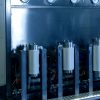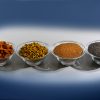
In a supercritical state, CO2 is characterized by mixed properties between gaseous and liquid state, so it is an excellent and effective apolar solvent, for the extraction of solutes having a low polarity, so similar that it can be compared to hexane. Looking at the table below, you can understand how, at constant pressure and increasing temperature, the properties of CO2 change considerably. In particular, the volume increases, while density and viscosity decrease, therefore an increase in the capillarity of gas is obtained, this gas at P equal to 80 bar and T equal to 31 ° C (conditions highlighted in orange) is in fact in the supercritical phase, no longer gaseous.
| Temperature (°C) | Density (kg/m3) | Volume (m3) | Viscosity (cP) | Phase |
| 0 | 961,94 | 0,0010396 | 0,10989 | Liquid |
| 20 | 827,71 | 0,0012081 | 0,075717 | Liquid |
| 31 | 679,73 | 0,0014712 | 0,05332 | Supercritical |
| 40 | 277,9 | 0,0035985 | 0,022345 | Supercritical |
| 60 | 191,62 | 0,0052186 | 0,020026 | Supercritical |
| 80 | 160,34 | 0,0062368 | 0,020046 | Supercritical |
| 100 | 141,27 | 0,0070784 | 0,020481 | Supercritical |
Comment on the table above: from the data reported, it can be seen that the density of the supercritical fluid reaches that of the liquid, in conditions of relatively low temperature (around 30° C) and high pressures. The ability to solubilize is therefore close to that of a liquid and, in some cases, even higher. Diffusivity stabilizes on intermediate values between liquid and gas. Finally, the viscosity is close to the values of the gaseous state. It follows that: the best transport properties of supercritical CO2 expressed by these data (better viscosity and diffusivity than that of a liquid) demonstrate how the speed with which supercritical CO2 is able to interact with the solute to be extracted is greater compared to that of an organic solvent not in supercritical conditions. Therefore CO2 in the liquid / supercritical state has very low surface tension and viscosity values, combined with a high solvent power, in particular for low-polar or apolar compounds. It can be used easily at room temperature (<32° C) and pressures of 50-60 bar.
Compared to the classic organic solvents used in extraction processes such as hexane, carbon dioxide has some advantages such as:
- It is not toxic for professional workers and for the surrounding environment.
- It has a low cost and it can be easily released into the atmosphere, as previously concentrated CO2 from the atmosphere is used, therefore the emissions are zero.
- After the solubilization of the compounds of interest, it can be easily converted back to the gaseous state and eliminated without further procedures. In this way, a finished product can be obtained without a trace of solvents.
- With a Tc close to the environmental one, the damages to the thermolabile substances are reduced and the final product will be more valid and safe.
- By saturating the extraction chamber in a short time, chemical and biological oxidative processes that could alter the matrix or the compounds to be extracted are inhibited.
- Being a low molecular weight gas, each matrix will have a high permeability for it, and therefore the extraction time will be shorter than the other solvents.


